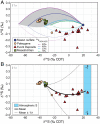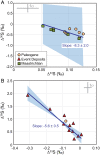Massive perturbations to atmospheric sulfur in the aftermath of the Chicxulub impact
- PMID: 35312339
- PMCID: PMC9168947
- DOI: 10.1073/pnas.2119194119
Massive perturbations to atmospheric sulfur in the aftermath of the Chicxulub impact
Abstract
SignificanceSulfur isotopes confirm a key role for atmospheric sulfur gases in climatic cooling, mass extinction, and the demise of dinosaurs and other global biota after the Chicxulub bolide impact at the Cretaceous-Paleogene boundary. The sulfur isotope anomalies are confined to beds containing ejecta and, in the immediately overlying sediments, are temporally unrelated to known episodes of volcanism that also bracket this event, further addressing the controversial role of the Deccan Traps in the extinction.
Keywords: K-Pg extinction; mass extinction; mass-independent fractionation; sulfur cycle; sulfur isotopes.
Conflict of interest statement
The authors declare no competing interest.
Figures



References
-
- Jablonski D., Extinctions in the fossil record. Philos. Trans. R. Soc. Lond. B Biol. Sci. 344, 11–17 (1994).
-
- Bambach R. K., Knoll A. H., Wang S. C., Origination, extinction, and mass depletions of marine diversity. Paleobiology 30, 522–542 (2004).
-
- Alroy J., The fossil record of North American mammals: Evidence for a Paleocene evolutionary radiation. Syst. Biol. 48, 107–118 (1999). - PubMed
-
- Schulte P., et al. , The Chicxulub asteroid impact and mass extinction at the Cretaceous-Paleogene boundary. Science 327, 1214–1218 (2010). - PubMed
MeSH terms
Substances
Associated data
LinkOut - more resources
Full Text Sources

